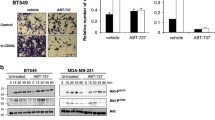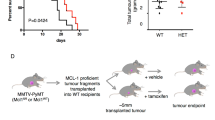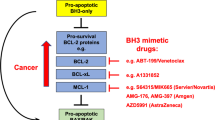Abstract
Ionising radiation, hypoxia, and the cyclooxygenase-2 inhibitor Celecoxib are known agonists of the intrinsic apoptosis pathway that involves mitochondrial damage upstream of caspase activation. Mitochondrial integrity is regulated by the pro-apoptotic Bcl-2 protein family members Bak and Bax. Upstream of the mitochondria, many kinases and phosphatases control the apoptotic response. However, the role of the non-receptor tyrosine kinase p56/Lck during apoptosis is controversial. The present investigation demonstrate the existence of two JCaM1.6 subclones, one expressing and one deficient for Bak. The lack of p56/Lck expression in JCaM1.6 cells per se did hardly affect apoptosis induced by ionising radiation, hypoxia, or Celecoxib. Only the additional loss of Bak expression, as observed in one JCaM1.6 subclone, rendered the cells resistant. siRNA-mediated downregulation of Bak and p56/Lck mimicked the observed effects in the subclones. Earlier experiments performed with the Bak-negative clone might have lead to the wrong assumption that lack of p56/Lck alone, and not the additonal loss of Bak, was responsible for reduced sensitivity towards stimuli of the intrinsic apoptosis pathway.



Similar content being viewed by others
References
Belka C et al (2000) Differential role of caspase-8 and BID activation during radiation- and CD95-induced apoptosis. Oncogene 19(9):1181–1190. doi:10.1038/sj.onc.1203401
Jendrossek V, Handrick R, Belka C (2003) Celecoxib activates a novel mitochondrial apoptosis signaling pathway. FASEB J 17(11):1547–1549
Weinmann M et al (2004) Molecular ordering of hypoxia-induced apoptosis: critical involvement of the mitochondrial death pathway in a FADD/caspase-8 independent manner. Oncogene 23(21):3757–3769. doi:10.1038/sj.onc.1207481
You H et al (2006) FOXO3a-dependent regulation of Puma in response to cytokine/growth factor withdrawal. J Exp Med 203(7):1657–1663. doi:10.1084/jem.20060353
Green DR (2005) Apoptotic pathways: ten minutes to dead. Cell 121(5):671–674. doi:10.1016/j.cell.2005.05.019
Harris MH, Thompson CB (2000) The role of the Bcl-2 family in the regulation of outer mitochondrial membrane permeability. Cell Death Differ 7(12):1182–1191. doi:10.1038/sj.cdd.4400781
Adams JM, Cory S (2007) The Bcl-2 apoptotic switch in cancer development and therapy. Oncogene 26(9):1324–1337. doi:10.1038/sj.onc.1210220
Green DR (2007) Life, death, BH3 profiles, and the salmon mousse. Cancer Cell 12(2):97–99. doi:10.1016/j.ccr.2007.07.011
Junttila MR, Li SP, Westermarck J (2008) Phosphatase-mediated crosstalk between MAPK signaling pathways in the regulation of cell survival. Faseb J 22(4):954–965
Osaki M, Oshimura M, Ito H (2004) PI3 K-Akt pathway: its functions and alterations in human cancer. Apoptosis 9(6):667–676. doi:10.1023/B:APPT.0000045801.15585.dd
Vlahovic G, Crawford J (2003) Activation of tyrosine kinases in cancer. Oncologist 8(6):531–538. doi:10.1634/theoncologist.8-6-531
Samraj AK et al (2006) The tyrosine kinase Lck is a positive regulator of the mitochondrial apoptosis pathway by controlling Bak expression. Oncogene 25(2):186–197
Molina TJ et al (1992) Profound block in thymocyte development in mice lacking p56lck. Nature 357(6374):161–164. doi:10.1038/357161a0
Penninger J et al (1993) Requirement for tyrosine kinase p56lck for thymic development of transgenic gamma delta T cells. Science 260(5106):358–361. doi:10.1126/science.8469988
Straus DB, Weiss A (1992) Genetic evidence for the involvement of the lck tyrosine kinase in signal transduction through the T cell antigen receptor. Cell 70(4):585–593. doi:10.1016/0092-8674(92)90428-F
Belka C et al (1999) The tyrosine kinase lck is required for CD95-independent caspase-8 activation and apoptosis in response to ionizing radiation. Oncogene 18(35):4983–4992. doi:10.1038/sj.onc.1202878
Gruber C et al (2004) Involvement of tyrosine kinase p56/Lck in apoptosis induction by anticancer drugs. Biochem Pharmacol 67(10):1859–1872. doi:10.1016/j.bcp.2004.01.026
Hur YG, Yun Y, Won J (2004) Rosmarinic acid induces p56lck-dependent apoptosis in Jurkat and peripheral T cells via mitochondrial pathway independent from fas/fas ligand interaction. J Immunol 172(1):79–87
Manna SK, Sah NK, Aggarwal BB (2000) Protein tyrosine kinase p56lck is required for ceramide-induced but not tumor necrosis factor-induced activation of NF-kappa B, AP-1, JNK, and apoptosis. J Biol Chem 275(18):13297–13306. doi:10.1074/jbc.275.18.13297
Belka C et al (2003) The tyrosine kinase Lck is involved in regulation of mitochondrial apoptosis pathways. Oncogene 22(2):176–185. doi:10.1038/sj.onc.1206103
al-Ramadi BK, Zhang H, Bothwell AL (1998) Cell-cycle arrest and apoptosis hypersusceptibility as a consequence of Lck deficiency in nontransformed T lymphocytes. Proc Natl Acad Sci USA 95(21):12498–12503. doi:10.1073/pnas.95.21.12498
Krystal GW et al (1998) Lck associates with and is activated by Kit in a small cell lung cancer cell line: inhibition of SCF-mediated growth by the Src family kinase inhibitor PP1. Cancer Res 58(20):4660–4666
Fletcher JI, Huang DC (2008) Controlling the cell death mediators Bax and Bak: puzzles and conundrums. Cell Cycle 7(1):39–44
Tuosto L, Marinari B, Piccolella E (2002) CD4-Lck through TCR and in the absence of Vav exchange factor induces Bax increase and mitochondrial damage. J Immunol 168(12):6106–6112
Cuevas B et al (1999) SHP-1 regulates Lck-induced phosphatidylinositol 3-kinase phosphorylation and activity. J Biol Chem 274(39):27583–27589. doi:10.1074/jbc.274.39.27583
Manna SK, Aggarwal BB (2000) Differential requirement for p56lck in HIV-tat versus TNF-induced cellular responses: effects on NF-kappa B, activator protein-1, c-Jun N-terminal kinase, and apoptosis. J Immunol 164(10):5156–5166
Papa S et al (2004) Linking JNK signaling to NF-kappaB: a key to survival. J Cell Sci 117(Pt 22):5197–5208. doi:10.1242/jcs.01483
Taichman RS et al (1992) Gene transfer investigations of p56-LCK function in IL-2-dependent T-cell lines: implications for mechanisms of IL-2-signal transduction. Cytokine 4(6):441–453. doi:10.1016/1043-4666(92)90004-B
Di Somma MM et al (1995) p56lck plays a key role in transducing apoptotic signals in T cells. FEBS Lett 363(1–2):101–104. doi:10.1016/0014-5793(95)00292-H
Garcia-Welsh A et al (1994) Cellular depletion of p56lck during thymocyte apoptosis. J Leukoc Biol 56(4):528–532
Skov S, Bregenholt S, Claesson MH (1997) MHC class I ligation of human T cells activates the ZAP70 and p56lck tyrosine kinases, leads to an alternative phenotype of the TCR/CD3 zeta-chain, and induces apoptosis. J Immunol 158(7):3189–3196
Acknowledgments
The work was supported by grants from the Federal Ministry of Education and Research (Fö. 01KS9602) and the Interdisciplinary Center of Clinical Research Tübingen (IZKF) (1468 and 1597) as well as the Deutsche Krebshilfe/Mildred-Scheel-Stiftung (107388).
Author information
Authors and Affiliations
Corresponding author
Electronic supplementary material
Below is the link to the electronic supplementary material.
Rights and permissions
About this article
Cite this article
Rudner, J., Mueller, AC., Matzner, N. et al. The additional loss of Bak and not the lack of the protein tyrosine kinase p56/Lck in one JCaM1.6 subclone caused pronounced apoptosis resistance in response to stimuli of the intrinsic pathway. Apoptosis 14, 711–720 (2009). https://doi.org/10.1007/s10495-009-0342-x
Published:
Issue Date:
DOI: https://doi.org/10.1007/s10495-009-0342-x




